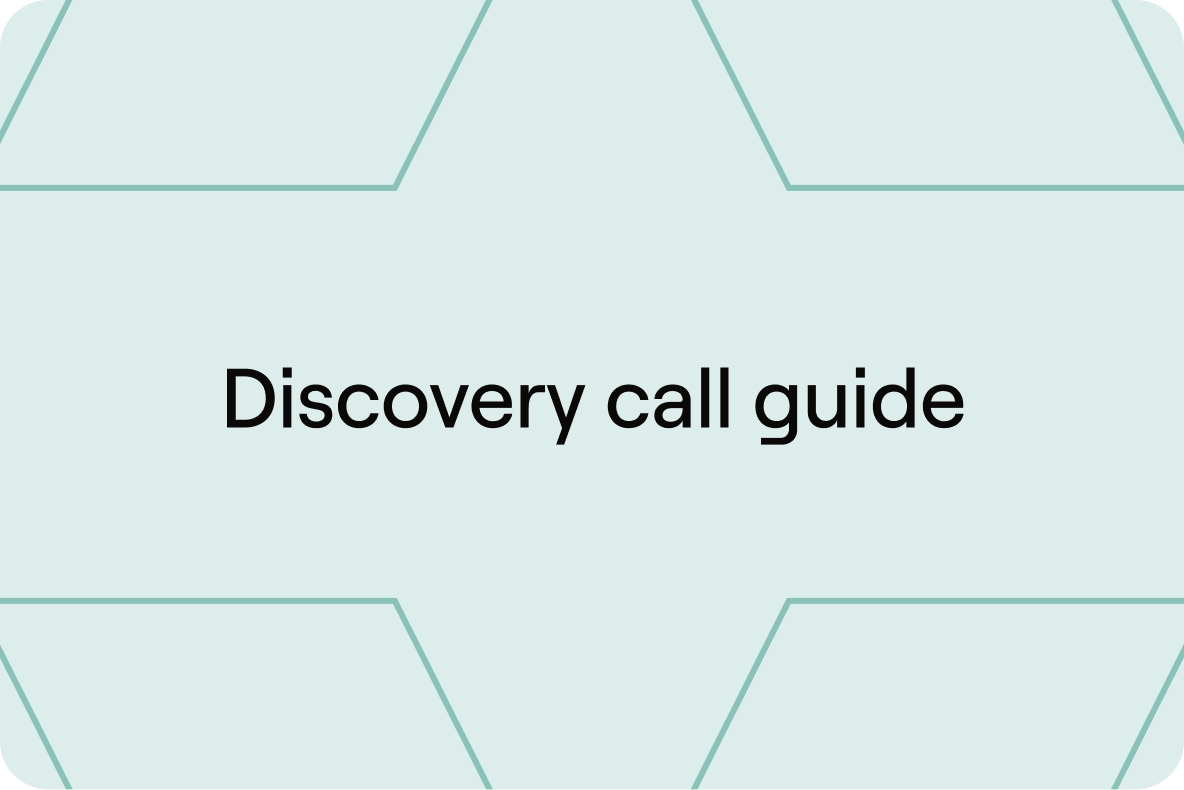Half of your prospects will never buy from you. Not because they don't like you, but because they're genuinely not a fit. Discovery calls exist to figure out which half is which before you waste weeks chasing ghosts.
Most sales reps treat discovery like a DMV appointment: ask a few generic questions, check some boxes, advance to the next stage. They miss the strategic opportunity hiding in plain sight. A well-run discovery call diagnoses business impact, maps stakeholder priorities, and creates urgency that turns "maybe next quarter" into "let's move now."
This guide shows you how to run discovery calls that uncover pain your competitors miss, quantify business impact in dollars and hours, and accelerate deals without pushy tactics. We'll cover frameworks, best practices tips, and templates and show you AI can help with the process.
What is a discovery call?
A discovery call is the first substantive conversation between a sales rep and a qualified prospect who has expressed buying intent. The purpose is to uncover pain points, assess fit, qualify opportunity viability, and determine if both parties should invest time advancing the relationship.
"Discovery" refers to mutual exploration. Both buyer and seller are discovering if there's alignment worth pursuing. Good discovery feels collaborative, not transactional.
- Discovery call definition: An initial B2B sales conversation designed to diagnose prospect challenges, goals, and solution fit.
- Synonyms: Qualification call, needs assessment call, exploratory call.
- What discovery calls are not:
- Not pitches (save product demos for later)
- Not interrogations (two-way conversations, not one-way question dumps)
- Not one-time events (discovery continues throughout the sales cycle)
- Discovery vs. demo calls: Discovery focuses on understanding; demos focus on showing solutions.
- Discovery vs. sales calls: Discovery qualifies and explores; closing calls negotiate and finalize.
Think of discovery calls as diagnostic medicine for sales. You're not prescribing solutions yet. You're running tests, asking questions, and mapping symptoms to root causes.
Why discovery calls matter
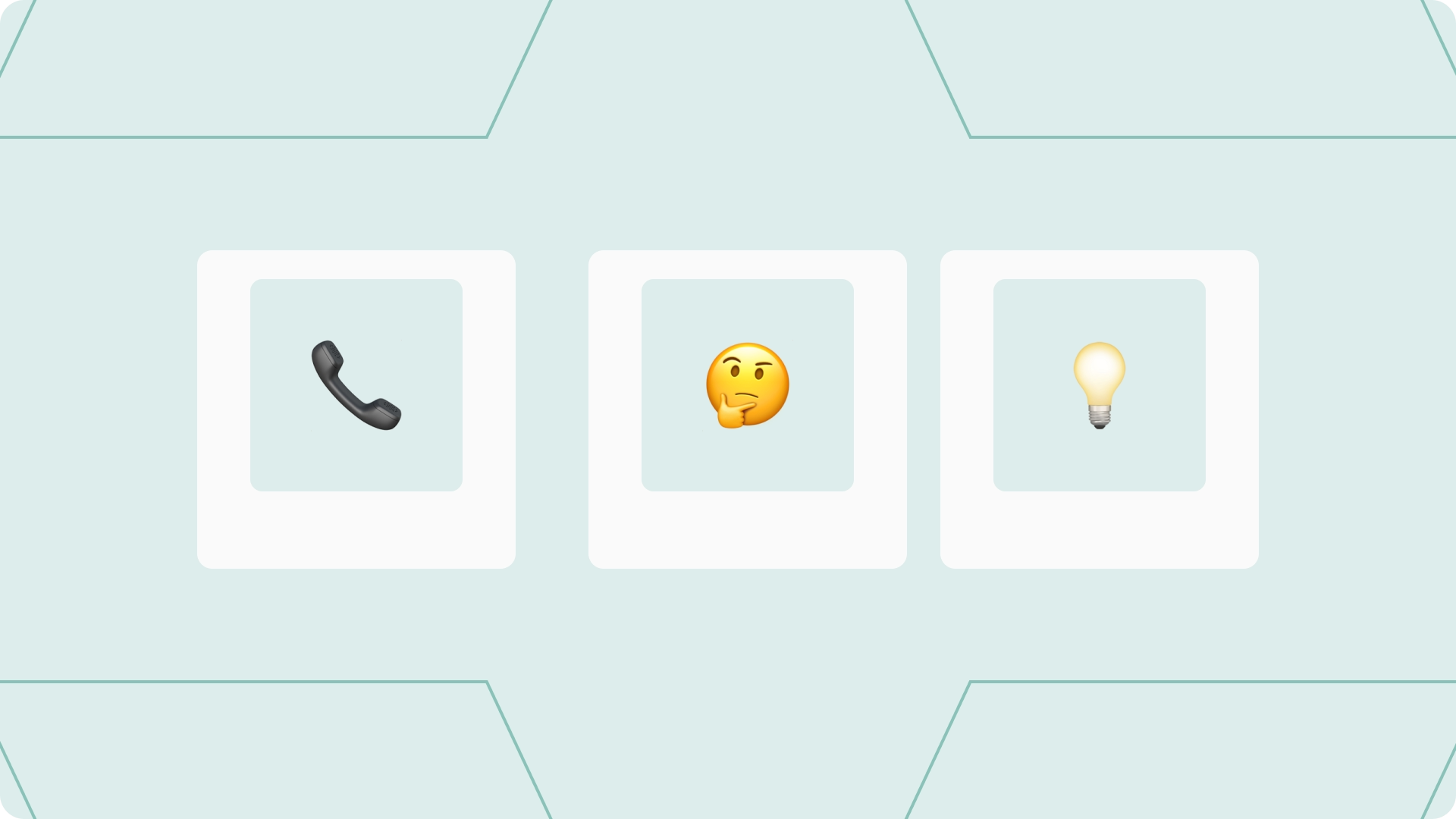
Discovery calls determine whether a deal is worth pursuing, lay the foundation for trust-based relationships, and provide the diagnostic insights you need to tailor solutions to specific business problems.
For sales reps:
- Qualify or disqualify fast. Save weeks chasing deals that won't close.
- Uncover real pain. Move beyond surface symptoms to executive-level business impact.
- Build credibility. Show up informed, ask smart questions, earn trust from minute one.
- Create urgency. Tie pain to business consequences that demand action.
For sales leaders:
- Pipeline quality control. Separate real opportunities from vanity metrics.
- Forecast accuracy. Better qualification means more reliable revenue predictions.
- Coaching leverage. Discovery call recordings reveal skill gaps and coaching opportunities.
- Deal velocity. Well-qualified deals move faster through your funnel.
For revenue operations:
- Pattern recognition. Analyze hundreds of discovery calls to identify what works.
- Process optimization. Identify which questions and frameworks correlate with closed-won deals.
- Enablement intelligence. Know exactly what content, collateral, and training gaps exist across your team.
The cost of bad discovery:
- Wasted cycles on unqualified leads.
- Missed quota because reps focus on the wrong deals.
- Longer sales cycles due to unclear pain or stakeholder misalignment.
- Lower win rates because you’re pitching solutions to problems prospects don’t actually care about.
Gartner predicts 75% of B2B buyers will prefer human interaction over AI by 2030. This means discovery calls will remain mission-critical for building sales motion and relationships AI can’t replace.
6 step process to ace discovery calls
Follow this step-by-step process to build your own discovery call framework or audit your current practices.
1. Pre-call preparation
Show up informed or lose credibility in the first 3 minutes. Top performers research prospects before every call.
Here's how to prepare:
- Research the company: Recent news, funding rounds, product launches, org structure, revenue, tech stack, industry trends.
- Research the individual: LinkedIn profile, role, tenure, shared connections, recent posts, pain points relevant to their role.
- Define your call objectives: What business problems does your product solve? What qualification criteria must this prospect meet? What’s your hypothesis about their pain? What outcome would make this call successful?
- Prepare your discovery questions: Draft 11–14 targeted, open-ended questions. Organize them by sales framework your team uses. Anticipate objections and prepare responses.
Bonus: How to prepare for a discovery call with AI
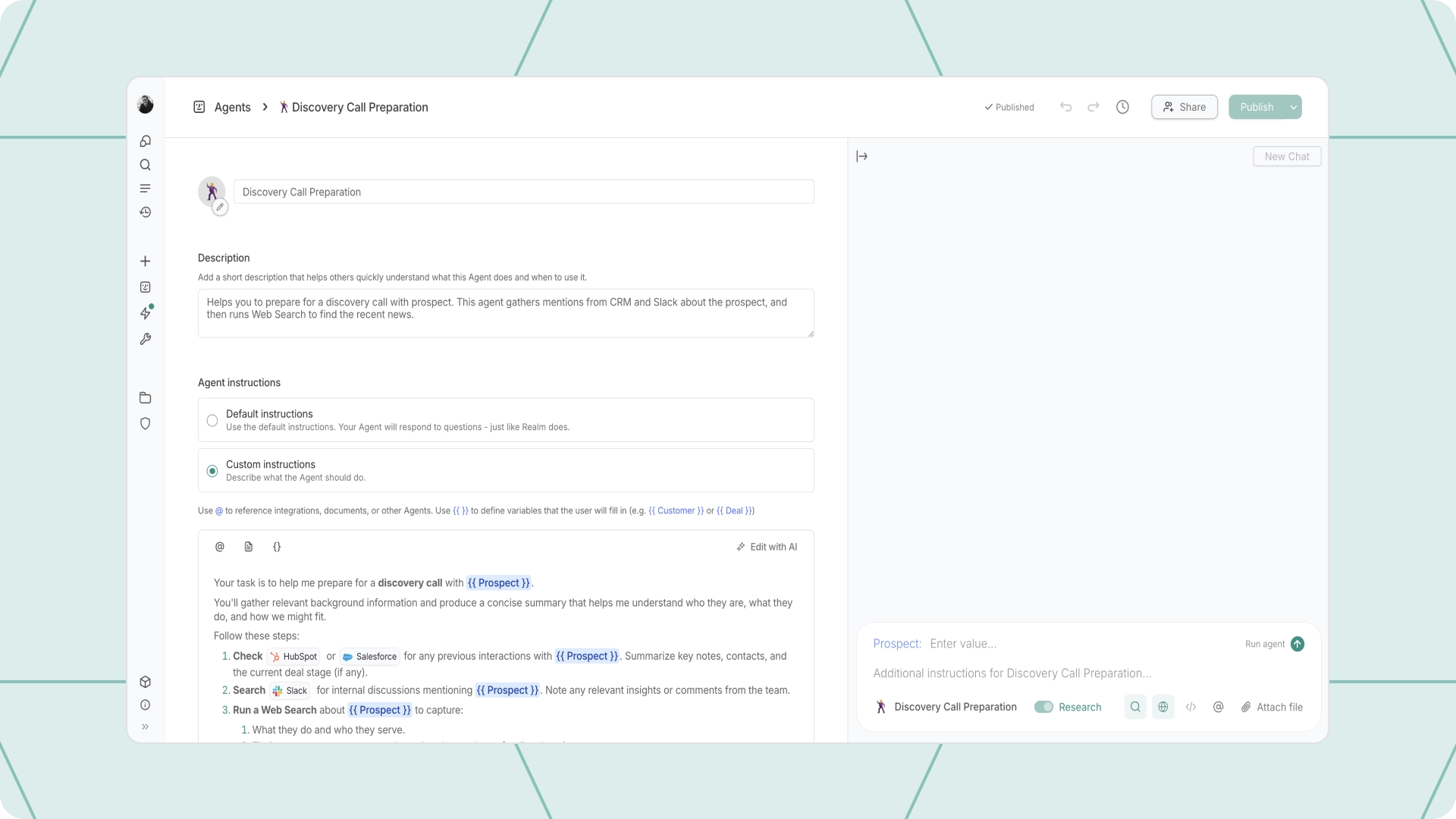
Too many sales reps scramble to research prospects minutes before the call, miss critical context buried in CRM notes or Slack threads, and ask generic questions that don't resonate.
Realm’s Discovery Call Prep AI Agent. The agent automatically research accounts, surface relevant pain points from past conversations, and generate customized question sets based on prospect profile cutting your prep time to minutes.
Here's how it works:
- Reviews CRM history by checking HubSpot or Salesforce for previous interactions, key contacts, notes, and current deal stage
- Surfaces internal context by searching Slack for team discussions, insights, or comments about the prospect
- Researches the company by running web searches to understand what they do, who they serve, company size, location, products, and recent news
- Identifies value alignment by analyzing potential pain points or goals that match Realm's capabilities, such as complex sales cycles, documentation challenges, or RFP automation
- Delivers a structured brief with one-paragraph company overview, key contacts and roles, recent relevant context (funding, launches, expansion), and potential value areas
- Provides discovery questions with 3-5 suggested talking points tailored to the prospect's business and likely challenges
The result? Better first impressions, more productive discovery calls, higher qualification rates, and faster progression to next steps
2. Opening the call
The first 5 minutes set the tone. Skip the small talk. Instead open start with ACE: open with appreciation, confirm time, and align on goals.
ACE framework consists of:
- Appreciate: Thank them for their time.
- Confirm time: “We have 30 minutes today—does that still work?”
- End goal: Set the agenda and desired outcome.
Here's and example opening based on the framework:
“Thanks for making time today. I know you’re busy, so I want to make sure we use these 30 minutes well. Here’s what I’d like to cover: first, I’d love to understand your current sales process and any challenges you’re facing around {{specific pain point}}. Then, if it makes sense, we can discuss how other companies in {{industry}} are tackling similar issues. By the end, we should both know if it’s worth exploring this further. Does that work for you?”
Why this approach works? Because it shows you came prepared, gives them a roadmap, makes the call collaborative, and gets their buy-in upfront. Avoid generic small talk, launching into your pitch, skipping agenda-setting.
3. The diagn phase
This is where you diagnose. Ask strategic questions, listen actively, and map pain to business impact. Your goal: uncover 3–4 meaningful problems worth solving.
Here's what to focus on:
- Talk-to-listen ratio: According to Gong top performers talk 46% of the time; low performers talk 72%.
- Number of questions to ask: 11–14 targeted questions, spread naturally throughout the conversation.
- Framing of quesitons: Ask “How” questions to stay at the current layer; “Why” questions to go deeper; use context to show you did your homework; use multiple-choice to steer the conversation.
- Sales frameworks: Your discovery questions should tie back to the sales methodology your organization uses whether it's SPICED, MEDDPICC, BANT, or something else.
- Active listening: Validate their pain, paraphrase to confirm understanding, take notes.
What to avoid? Yes/no questions, dominating the conversation, pitching solutions before diagnosing pain, generic questions, ignoring buying signals or objections.
4. Demonstrating value through storytelling
Data and features are forgettable. Stories stick. Share relevant customer examples that mirror the prospect’s situation.
How to structure a story:
- Situation: “We worked with companies like yours — {{industry, size, similar pain}}.”
- Problem: “They were struggling with {{specific challenge}}.”
- Solution: “They started using {{your product/feature}}.”
- Outcome: “Now they’re {{quantified result: 3x faster, $500K in saved costs, 40% higher win rates}}.”
Here's an example of how to tell a story to demonstrate value:
“Your situation reminds me of another RevOps leader I spoke with last quarter at a Enterprise SaaS company about your size. They were drowning in RFP requests, taking 10+ hours per response, and their sales team was frustrated because they couldn’t get answers from SMEs fast enough. They implemented Realm, and now they’re completing questionnaires in automaticaly. They’ve cut response time by 3x and closed 2 deals they would have lost due to slow turnaround. Does that resonate with what you’re facing?”
You might wonder why storytelling works? Prospects remember stories far better than facts and features. Stories build trust, help prospects see themselves in the solution, and create emotional resonance.
5. Closing the call & setting next steps
The last 5 minutes determine whether this deal has legs. Validate mutual interest, address objections, and lock in next steps with clear action items.
The 5-minute drill:
- Summarize the pain: “So to recap, you’re spending 20 hours per RFP, losing deals to faster competitors, and your team is burned out. Does that capture it?”
- Confirm you can help: “Based on what we’ve discussed, I think we can help you {{specific outcome}}. Here’s how...”
- Check their interest: “Does this sound like something worth exploring?”
- Surface objections: “Do you have any concerns or questions I can address now?”
- Set next steps: “Great. The logical next step would be {{demo, technical deep-dive, exec meeting}}. How does {{specific date/time}} work for you?”
Here's an example on how to make the next steps specific:
“Let’s schedule a 45-minute demo on Thursday at 2pm where I’ll show you how we automate RFP responses. I’ll also bring our Solutions Engineer to answer technical questions. Can you bring your Sales Ops lead so they can see the workflow?”
Remember that disqualification is OK. Not every prospect is a good fit, and that’s fine. If they don’t have budget, urgency, or authority, it’s better to disqualify early.
6. Post-call follow-up

The fortune are made by following through. Send a follow up email that summarizes pain, proposed solution, and next steps with 24 hours from the call.
What to include in your follow-up email after a discovery call:
- Subject line: Clear and specific “Next Steps: {{Company name}} + Realm)
- Greeting: Friendly but concise
- Thank you: Show appreciation of their time
- Recap of pain points: “Here’s what I heard: {{bullet list of their challenges}}”
- How you can help: “Based on our conversation, here’s how we can address those challenges...”
- Resources: Attach relevant case studies, one-pagers, or ROI calculators
- Next steps: Confirm the next meeting (date, time, agenda)
Pro tip: You can use Realm Assistant and our Gong connector to automate the follow-up emails after your sales calls.
How to structure a discovery call
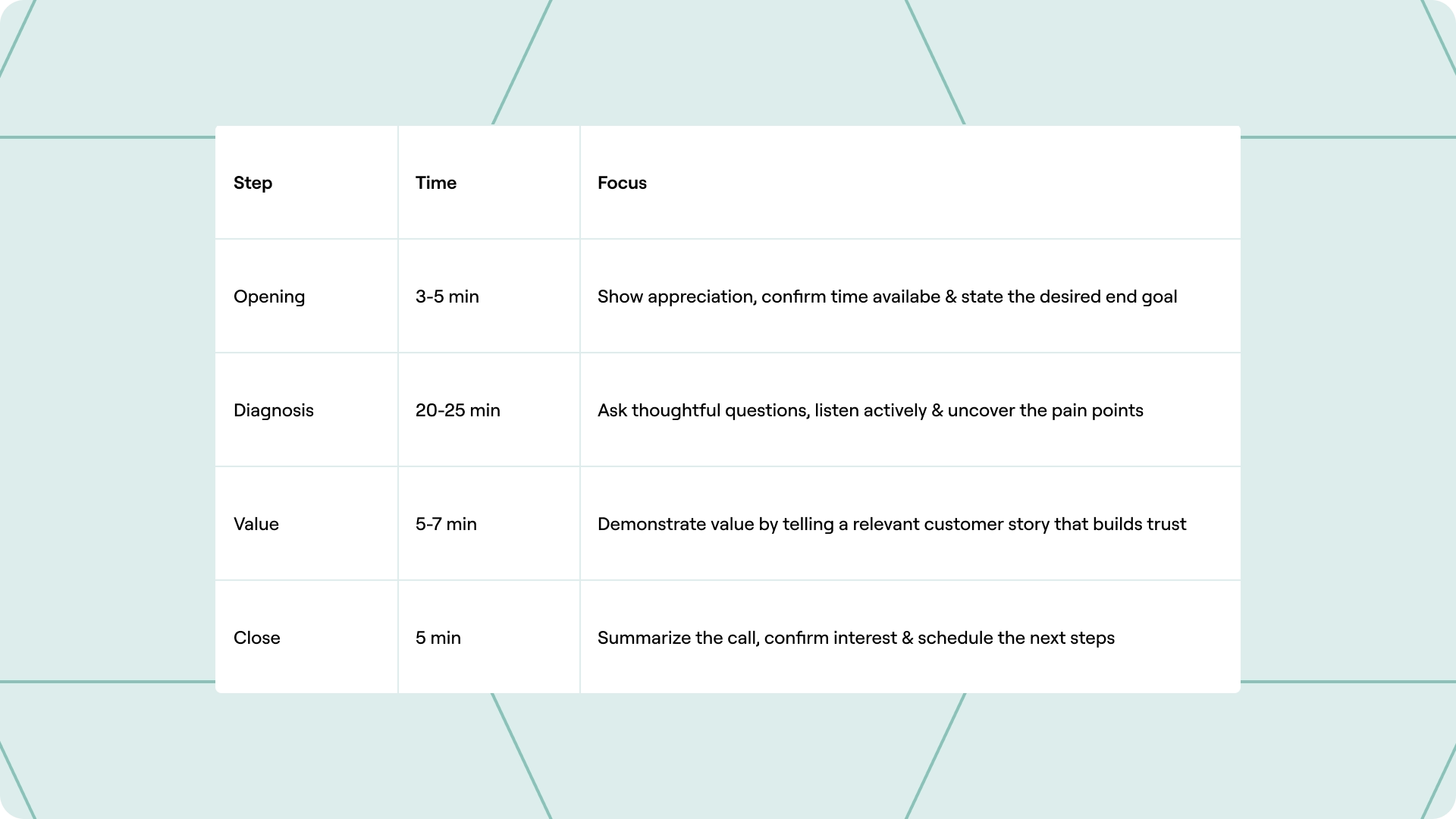
How long should a discovery call be?
It depends on the your market, product, and customer segment. As a rule of thumb:
- Transactional deals: 15–30 minutes
- Mid-market deals: 30–45 minutes
- Enterprise deals: 45–60 minutes
Discovery call question examples
The right discovery questions uncover pain, quantify impact, and reveal urgency. Here are example questions to inspire you.
Situational questions
- “Tell me about your current {{process/workflow}}.”
- “How many {{customers, deals, RFPs}} does your team handle per quarter?”
- “What tools are you using today to manage {{pain point}}?”
- “Who’s responsible for {{task}} on your team?”
Pain questions
- “What’s the biggest challenge you’re facing with {{process}}?”
- “What’s frustrating your team the most about {{current state}}?”
- “Where are you losing the most time or money?”
- “What’s keeping you up at night?”
Impact questions
- “What’s the business impact of {{pain}}? Are you losing revenue, deals, or team productivity?”
- “How much time does your team spend on {{manual task}} each week?”
- “What’s the cost of not solving this problem?”
- “Who else in the organization is affected by this challenge?”
Urgency questions
- “Why are you looking to solve this now?”
- “What happens if you don’t fix this in the next 6 months?”
- “Is there a specific deadline or event driving this?”
- “What would change if you could solve this tomorrow?”
Decision-making questions
- “Who else needs to be involved in this decision?”
- “What does your typical buying process look like?”
- “What criteria will you use to evaluate solutions?”
- “Have you allocated budget for this?”
Objection-handling questions
- “Do you have any concerns about [product/solution] that I can address?”
- “What would prevent you from moving forward if we show you a solution that works?”
- “Have you looked at other options? What did you think?”
Disqualification questions
- “What’s your budget range for solving this problem?”
- “If we’re not a fit, that’s OK—what would make this not worth pursuing?”
- “Is this a top-3 priority for you this quarter?”
Remember that generic questions lead to generic answers. The best questions are personalized based on your research.
Discovery call best practices
Top-performing reps prepare relentlessly, ask better questions, listen more than they talk, and treat discovery as a collaborative diagnosis, not a checklist.
- Do your homework: top performers research every prospect before reaching out.
- Ask 11–14 questions: Not too few (under-qualified), not too many (interrogation).
- Uncover 3–4 problems: Enough to justify action, not so many it’s overwhelming.
- Talk 46% of the time: Listen more than you speak.
- Use open-ended questions: “What issues do you have with X?” not “Are you happy with X?”
- Validate pain points: “That sounds frustrating” or “I’ve heard that from others in your role.”
- Ask “Why” to go deeper: Move from surface symptoms to executive-level business impact.
- Tell relevant stories: Share customer examples that mirror their situation.
- Avoid pitching: Diagnose before prescribing.
- Set specific next steps: Lock in the next meeting with date, time, and agenda.
- Follow up within 24 hours: Send a recap email summarizing pain, solution, and next steps.
- Record and review calls: Use conversation intelligence tools like Gong and Realm's Sales Call Coaching AI Agent to improve over time.
Avoid dominating the conversation, asking generic questions, skipping agenda-setting, pitching before diagnosing, failing to summarize or confirm understanding, leaving without clear next steps, not following up.
Discovery call templates: Checklist, agenda & script
To get you started beyond Realm, here are practical templates to audit and improve your current discovery process. Copy, customize, and share them with your team.
Discovery call checklist
This discovery call checklist constains a list of items that need to be completed before, during, and after a discovery call within the sales process. You can use it for every opportunity, and soon you'll notice that you'll be doing all the right things automatically.
Before the call:
- Research the company (news, funding, tech stack, pain points)
- Research the individual (LinkedIn, role, tenure, shared connections)
- Review past interactions (emails, demo requests, content downloads)
- Define your hypothesis about their pain
- Prepare 11–14 targeted questions
- Set your call objectives – what makes this call successful?
- Draft your opening with ACE framework
During the call:
- Open with appreciation, time confirmation, and agenda
- Ask situational questions to set context
- Dig into pain with “Why” questions
- Quantify business impact
- Uncover critical event/urgency
- Identify decision-makers and buying process
- Share a relevant customer story
- Summarize pain and confirm understanding
- Set specific next steps (date, time, agenda)
- Address objections or concerns
After the call:
- Send follow-up email within 24 hours
- Attach relevant resources (case studies, ROI calculator)
- Confirm next meeting
- Update CRM with notes and qualification status
- Share recording with manager for coaching (if applicable)
Discovery call agenda
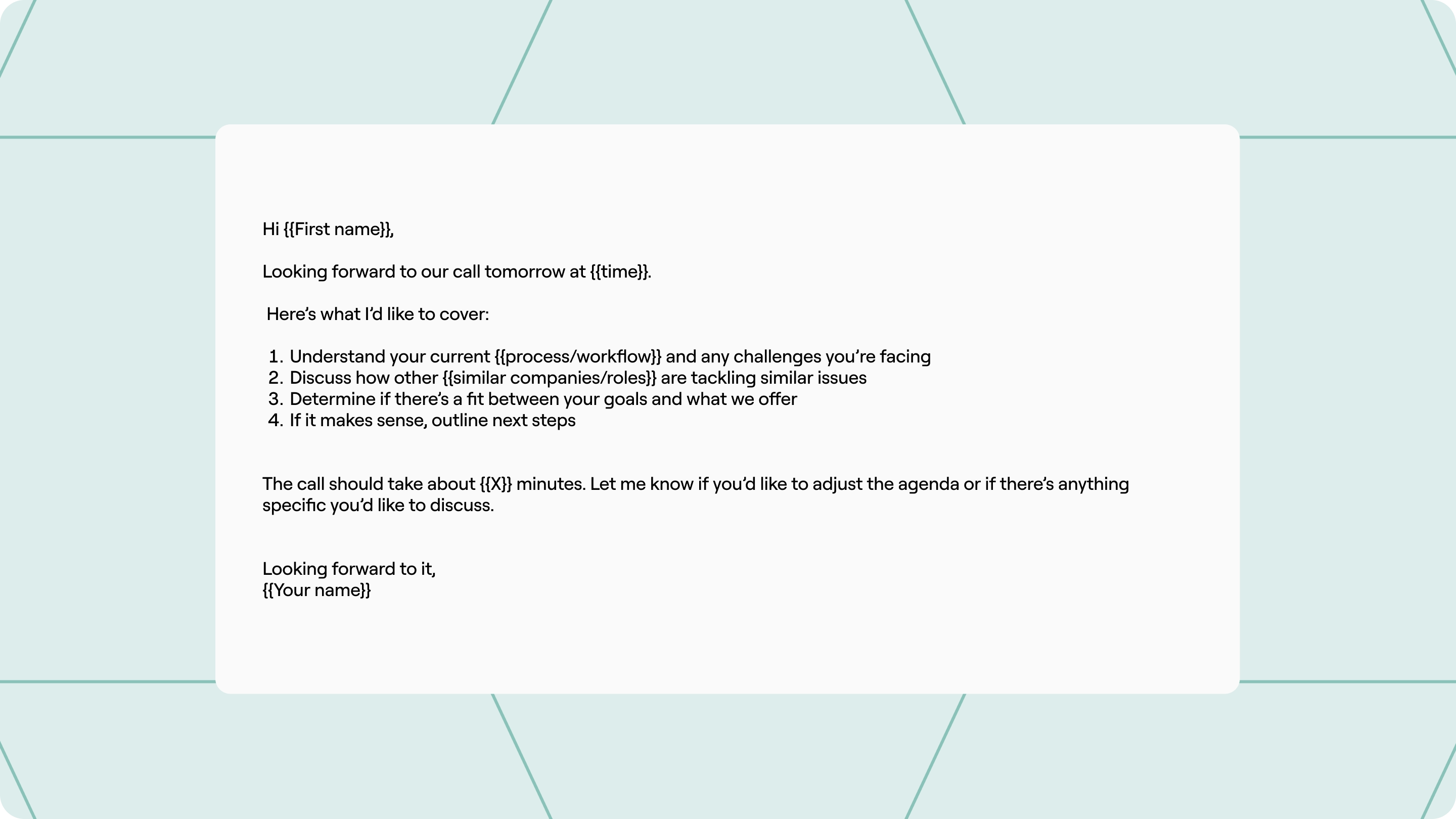
Your agenda for the discovery call should show professionalism, preparation, and respect for the prospect’s time. It builds trust before the call even begin, helping you start the conversation on the right note.
Here's what to include in your discovery call agenda:
- Subject line: Clear and professional – "Agenda for tomorrow’s call: {{Company name}} + {{Your company}}”
- Greeting: Friendly but concise – “Hi {{First name}}, looking forward to our call tomorrow at {{time}}.”
- Purpose of the email: Set expectations and show preparation – " {{bullet list of the talking points}}
- Duration: Respect their time – “The call should take about {{X}} minutes.”
- Invitation to collaborate: Encourage input – “Let me know if you’d like to adjust the agenda...”
You can save the example as template in your email tool, or even build an AI agent with Realm to automatically generate tailored agenda for each discovery call based on everything you know about the prospect.
Discovery call script
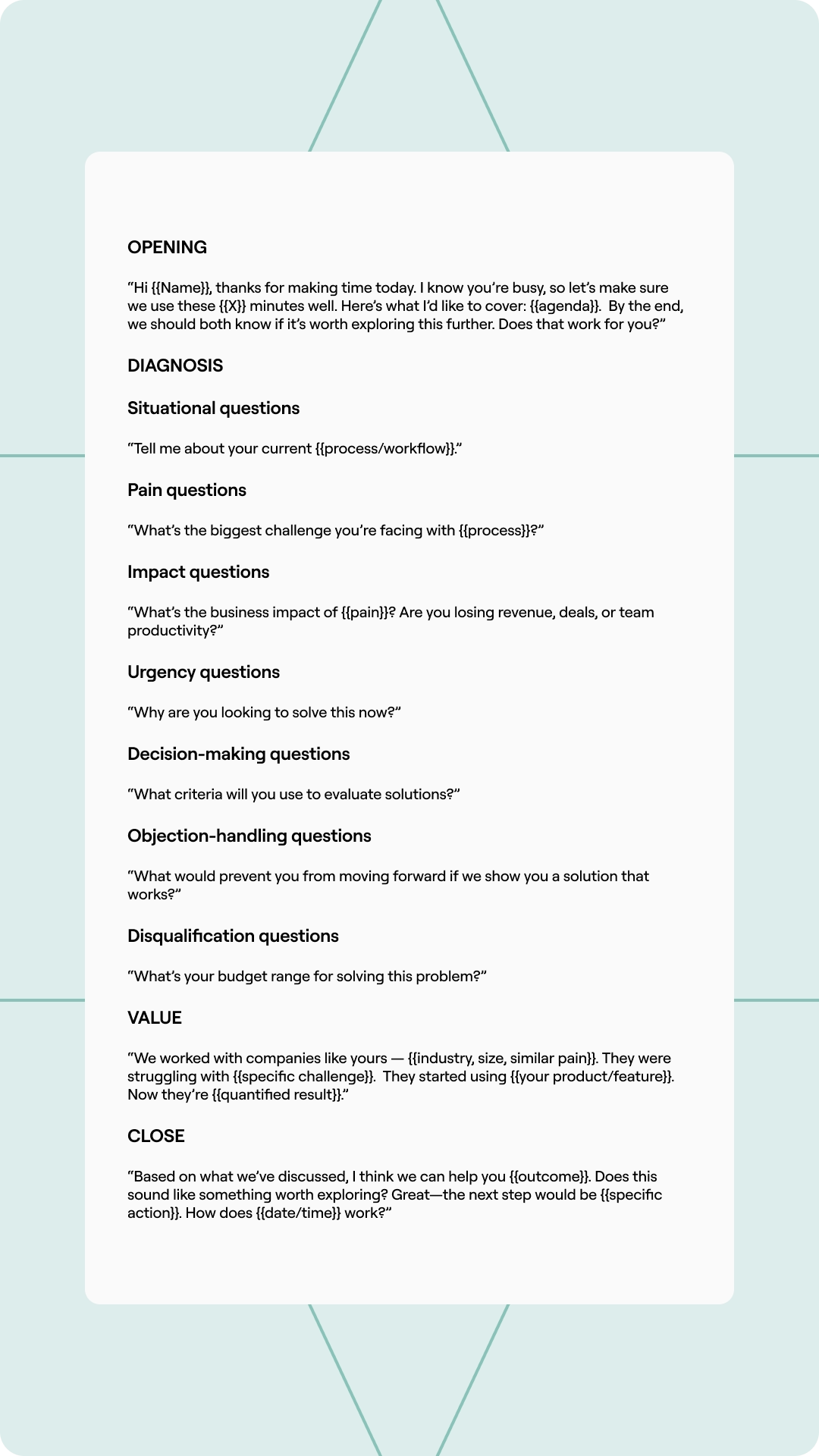
The best sellers will begin with an example discovery call script like the one above, and make it their own. You’re should not just add your own spin, but also adapting to the prospect’s needs and communication style as you go. Tailoring it based on everything your research has brought up about the prospect is something Realm Assistant can help.
Discovery call tips: Mock calls, role play & coaching
Discovery is a skill, not a script. That's why practice matters. The best reps train, seek feedback, and refine their approach.
Here are tips for improving your discovery calls:
- Mock discovery calls: Run mock calls internally with peers or managers. Use real scenarios and record the session for review.
- Role play: Take turns as buyer and seller. Challenge each other with tough objections and curveball questions.
- Coaching: Use tools like Realm’s Sales Call Coaching AI Agent to review you calls to highlight talk-time ratio, objections, and missed discovery questions.
These approaches are how you build muscle memory and confidence, and ultimately improve your discovery calls.
Final thoughts on discovery calls
Discovery calls are the linchpin of modern B2B sales. They’re not just a step in the process. They’re the foundation for every deal you’ll ever close. Use the frameworks, templates, and AI tools in this guide to and share them with your team to run better discovery calls across your organization. The difference between a mediocre quarter and a record-breaking one starts with how you run your next discovery call.

